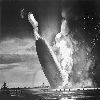
Soundtrack for the end of an era
Story behind the song
Bobby sent this concept backer my way, to see if I was interested in adding a noodle or two, this is what turned out.
Bobby Mack; Concept, Synths, Wirestring, Bass, Drums & Percussion.
Michael Duran; FX, Vox, Guitar, Flute, Strings & Violin.
Lyrics
With the delivery of LZ 126, the Zeppelin company had reasserted its lead in rigid airship construction, but it was not yet quite back in business.
Acquiring the necessary funds for the next project proved a problem in the difficult economic situation of post-World-War-I Germany, and it took Eckener two years of lobbying and publicity to secure the realization of LZ 127.
Another two years passed before the new dirigible, christened Graf Zeppelin in honor of the Count, flew for the first time on 18 September 1928. With a total length of 236.6 metres (776 ft) and a volume of 105,000 m3, it was the largest dirigible yet.
Eckener's initial concept was to use the Graf Zeppelin for experimental and demonstration purposes to prepare the way for regular airship travel carrying passengers and mail to cover the costs. In October 1928 the first long-range voyage brought her to Lakehurst, where Eckener and his crew were once more welcomed enthusiastically with confetti parades in New York and another invitation to the White House.
Later Graf Zeppelin toured Germany and visited Italy, Palestine, and Spain. A second trip to the United States was aborted in France due to engine failure in May 1929.
In August 1929 LZ 127 departed for another daring enterprise: a circumnavigation of the globe. The growing popularity of the "giant of the air" made it easy for Eckener to find sponsors. One of these was the American press tycoon William Randolph Hearst, who requested that the tour officially start in Lakehurst.
As with the October 1928 flight to New York, Hearst had placed a reporter, Grace Marguerite Hay Drummond-Haym on board, who thereby became the first woman to circumnavigate the globe by air. From Lakehurst, Graf Zeppelin flew to Friedrichshafen, then Tokyo, Los Angeles, and back to Lakehurst, in 21 days 5 hours and 31 minutes. Including the initial and final trips Friedrichshafen?Lakehurst and back, the dirigible traveled 49,618 kilometres (30,831 mi).
In the following year, Graf Zeppelin undertook a number of trips around Europe, and following a successful tour to Recife, Brazil in May 1930, it was decided to open the first regular transatlantic airship line.
This line operated between Frankfurt and Recife, offering 68 hour flights, and later, between Frankfurt and Rio de Janeiro, with a stop in Recife.
Despite the beginning of the Great Depression and growing competition from fixed-wing aircraft, LZ 127 transported an increasing volume of passengers and mail across the ocean every year until 1936.
The ship reached another spectacular venue in July 1931 with a research trip to the Arctic. This had already been a dream of Count von Zeppelin twenty years earlier, which could, however, not be realized at the time due to the outbreak of war.
Eckener intended to supplement the successful craft by another, similar Zeppelin, projected as LZ 128.
However the disastrous accident of a British passenger airship R101 on 5 October 1930 led the Zeppelin company to reconsider the safety of hydrogen-filled vessels, and the design was abandoned in favor of a new project.
LZ 129 would advance Zeppelin technology considerably, and was intended to be filled with inert helium.